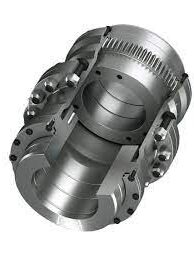Gear couplings customarily come in two varieties, flanged sleeve and continuous sleeve. Flanged gear couplings comprise of short sleeves encompassed by a perpendicular flange. One sleeve is set on each pole so the two flanges line up face to face. A series of screws or bolts the flanges hold them together.
A gear coupling flange is a mechanical component used to connect two shafts in a drivetrain or power transmission system. It consists of two flanges with internal teeth that are connected by a set of gears. The gear coupling flange is designed to transmit power and torque between the two shafts while allowing for some degree of misalignment, axial movement, and angular displacement.
Some of the benefits of using a gear coupling flange in power transmission systems include:
- High torque capacity: Gear coupling flanges can transmit high torque loads with minimal backlash, making them ideal for heavy-duty applications.
- Flexibility: Gear coupling flanges allow for some degree of angular displacement, axial movement, and misalignment between the two shafts, which can help to reduce stress and wear on the drivetrain.
- High speed capability: Gear coupling flanges can operate at high speeds with minimal vibration and noise, making them suitable for a wide range of applications.
- Easy maintenance: Gear coupling flanges are designed to be easy to maintain, with simple disassembly and reassembly procedures.
The Gear Coupling Flange is a versatile and reliable component in power transmission systems, providing high torque capacity, flexibility, high-speed capability, and easy maintenance. Proper installation, lubrication, and inspection of the gear coupling flange and its components are essential for ensuring its proper functioning and preventing any potential damage or wear that can affect the performance and safety of the system.



